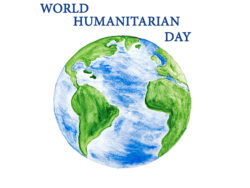Helping Youth Address Trauma from Exposure to Violence

By Esther Lee
In the era of social media which frequently engenders self-promotion, self-branding, and consumerism, the young generation seems to be moving further away from the ethos of humanitarian aid. Nonetheless, statistics say otherwise. Both the millennial and Gen Z generations gave more than other generations during the COVID-19 pandemic. Through online platforms such as GoFundMe, people realize that even their $5 can go a long way, transforming the lives of others. Perhaps this generation squares with what Dr. Albert Schweitzer dedicated his life to—recognizing that we mitigate harms and improve lives and dignities—their reverence for their life and others. We, as individuals, may not be able to address systemic social determinants of health, but we can acknowledge such fundamental causes of inequality while also doing our small part in leaving this world a better and more equal place as contemporary inhabitants of the earth.
In a similar spirit, my project will help youth address trauma symptoms due to violence exposure. The proposed community service project will employ different healing modalities for youth exposed to violence, gun violence. Because many gun violence offenders and victims have exposure to adverse childhood and adolescent experiences and traumas, this project will address the root causes of trauma to promote healing and well-being andreduce gun violence in the community. As for community healing, my project will employ a manifold of modalities within a healing-centered organizing approach: transformative organizing, restorative justice, contemplative practices, and urban youth culture, and contemporary culture. My project is not a panacea to solve youth violence or firearm violence. Instead, it is a small but important effort to care for the youth in this community (Detroit Heals Detroit) and make an improvement in their community.
With the advent of social media and rapid technological advances, we now have the tools to document the injustices, instigate empathy and compassion for others living in different realities, and inform ourselves. As seen in the Black Lives Matter movement, social media allows us to coalesce, mobilize, and galvanize like never before. Such tools also come with the ability to hold more individuals and institutions accountable. It is encouraging given that many organizations and individuals may have the spirit of humanitarian aid, but their good intentions are not enough to make any tangible, equitable impacts. Today, many people, cultures, and institutions are suffering as a result. With that in mind my project includes outcomes and impact evaluation to understand both the intended and unintended consequences. It will evaluate the outcomes through feedback and surveys from the youth. The primary goal of this project is sustainability in the future, once this project concludes, benefiting the youth and their communities for years to come.
Esther Lee is a 2022-23 Albert Schweitzer Fellow and doctoral student at the University of Michigan School of Public Health. Her blog post is one in a series written by Schweitzer Fellows to commemorate World Humanitarian Day, 2022.
